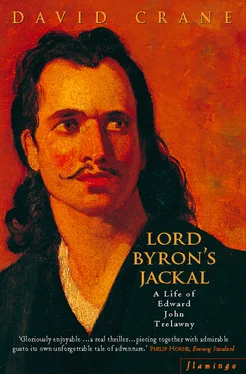On a July day in 1841 a group of foreigners gathered in the town’s Roman Catholic Church to add their own lie to the great historical deception that modern Nauplia enshrines. The Church of the Metamorphosis is a small domed building, perched alongside the Hotel Byron on a terrace beneath the walls of the upper town, looking out westwards across the bay towards the ruins of Argos and the Frankish citadel of Larissa. At its south east corner the foundations of an old minaret are visible, and inside the sense of space and air still feels closer to the mosque it once was than any Greek church. Above its altar, a copy of a Raphael Holy Family, the gift of Louis Philippe to King Otho, intrudes a fleshily different but no less alien note. Opposite it, framing the door in a sad parody of a triumphal arch, stands the monument that had brought the congregation to the church that day. It was the work of a Frenchman called Thouret, a ‘Lt. Colonel’ and a ‘Chevalier de Plusieurs Ordres’ he has signed himself with a gallic swagger. ‘A La Memoire Des Philhellènes’, it reads across the top, ‘Morts pour L’independance, La Grèce, Le Roi, et Leurs Compagnons D’Armes Reconnaissants.’ Down the length of its four pillars, inscribed in white on black wood, riddled with mis-spellings, are the names of almost three hundred foreign dead who in the decade before Otho’s arrival had come out to fight for Greek independence.
There can be few more forlorn memorials. Sometimes along the Dutch border one comes across a German cemetery from the last war buried deep in a wood, but even those graves with their air of furtive and collective guilt scarcely catch the sad futility that clings to Thouret’s monument. There is something about its shabby theatricality that nothing else quite matches, a sense of defeated grandeur and deluded optimism which inadvertently captures the fate of the men it commemorates. ‘Hellenes,’ it says, ‘we were and are with you.’ It is not true and it never was. Who, inside or outside Greece, has heard of a single Philhellene other than Byron? How many memorials are there raised by the Greeks themselves in their memory? How, if Greece had deliberately set out to disown their memory, could it have done better than here in Nauplia? – in a town synonymous with Philhellene disillusion, in a converted Turkish mosque given by a German King to the Roman Catholic Church? Could there be any more eloquent or insouciant tribute to the insignificance of these lives than to obliterate their identity in the crude errors and chaotic lettering of their only monument? *
Beneath its hollow rhetoric, however, is that common denominator which links its names with those on the monuments of villages, schools, hospitals or railway stations from the Falklands to Burma, from South Africa to Sevastopol. There is always a sharp poignancy in the way these memorials bring the familiar and strange into such permanent proximity, that lives begun on Welsh farms can end in the mission compound at Rorke’s Drift, and nowhere is that more vividly felt than here. Who in 1821 had heard of Missolonghi, Peta, or any of the other battle honours that punctuate the lists of Philhellene dead? What was it that brought William Washington here from America, to die on a British flagship in the harbour at Nauplia, killed by a Greek bullet? Or the nineteen-year-old Heise from Hanover to Peta – only to be beheaded on the field if he was lucky, and if not, forced to carry his comrades’ heads back to Arta before being impaled on the grey castellated walls of its Frankish citadel?
‘We are all Greeks,’ 3 Shelley proclaimed in 1821 with the largesse of a man firmly lodged in Italy, and yet if Washington and Heise might well have made the same claim it is less clear what they would have meant. There are certainly men here who would have echoed the language of Shelley’s ‘Hellas’, homeless refugees from monarchical despotism who would have died to keep the seventeen-year-old scion of the house of Wittelsbach or any other royal line out of Greece. There were men again for whom the war was a crusade, fought with all the polemical and emotional bitterness of religious war. ‘I wholly wish,’ one volunteer wrote, ‘to annihilate, extirpate and destroy those swarms and hordes of people called Turk.’ 4 Others fought because they had always fought and knew nothing else. There were young Byronists absorbed in some designer war of their own invention, charlatans attracted by the hope of profit, classicists infatuated with Greece’s past, Benthamite reformers, ageing Bonapartists – and then all those there for a dozen different motives, who might just once have known why they came but had long forgotten by the time they died.
‘For the most part the scum of their country,’ the English volunteer Frank Abney Hastings harshly wrote of them, ‘perhaps no crime can be named that might not have been found among the corps called Philhellenes.’ 5 This was a verdict, too, which Greek indifference would seem to have endorsed but one need only point to Hastings himself to qualify that judgement. *Or to Number 18 among the Missolonghi dead on the monument, General Normann – the same Normann who had found himself on different sides during the Napoleonic wars, fighting first against, then for, and finally against the French as his native Württemberg changed allegiance. He was in Greece as much to restore his tattered credit in his own eyes as in those of the world. Wounded at Peta, the man who had fought with the Austrians at Austerlitz and with the Grand Army on the retreat from Moscow, died grief-stricken at Missolonghi, finally broken by the last and bitterest disaster of his life.
There are twenty-five dead listed on this monument under Missolonghi; thirty-five under Nauplia; a single name, a man called Coffy, under Mitika; three under Parnassus and so on. In the first and last stages of the war some of these fought and died alongside their comrades, but for most of them these were lonely deaths in a struggle that had no shape and almost no battles, a conflict that wasted lives with a casual and purposeless savagery. There are no decorations after men’s names on this monument, no MM’s, no Croix de Guerre to suggest their courage or folly was ever recognized; no battalion names – no East Kents, no Artists’ Rifles, no Manchester Regiments – to promise any sense of comradeship. Some of them died of their wounds, some died mad, killed themselves or wasted from diseases. Some were killed by the Turks, others by the Greeks they had come to defend. Lord Charles Murray, a son of the Duke of Atholl, rich, generous and unbalanced, died in Gastoumi with a single dollar in his pocket. The eighteen year old Paul-Marie Bonaparte ran away from the university of Bologna only to shoot himself while cleaning his gun before he had so much as seen action. His corpse was kept for five years in a keg of rum in a Spetses monastery before being laid to rest on the island of Sphacteria. *
One of the more surprising ironies of history that this monument brings out is that if there was a single country that was relatively untouched by the excitement which swept Europe in 1821 it was Greece’s friend of popular mythology, Britain. It is true that in Thomas Gordon and Frank Abney Hastings Britain sent two of the wealthiest and most influential of the early Philhellenes, and yet in spite of all the committees formed and the pamphlets written, for a whole gamut of reasons that range from party politics to an oddly modern-looking compassion fatigue, no more than a dozen Britons actually made the journey out to Greece to fight during the first two years of the war.†
In the July of 1823, however, an ill-assorted menagerie of animals and men sailed from Genoa in an ugly, round-bottomed ‘tub’ on a voyage that would change this for good and hijack for Britain a place in Philhellene history it has never lost.
Читать дальше












